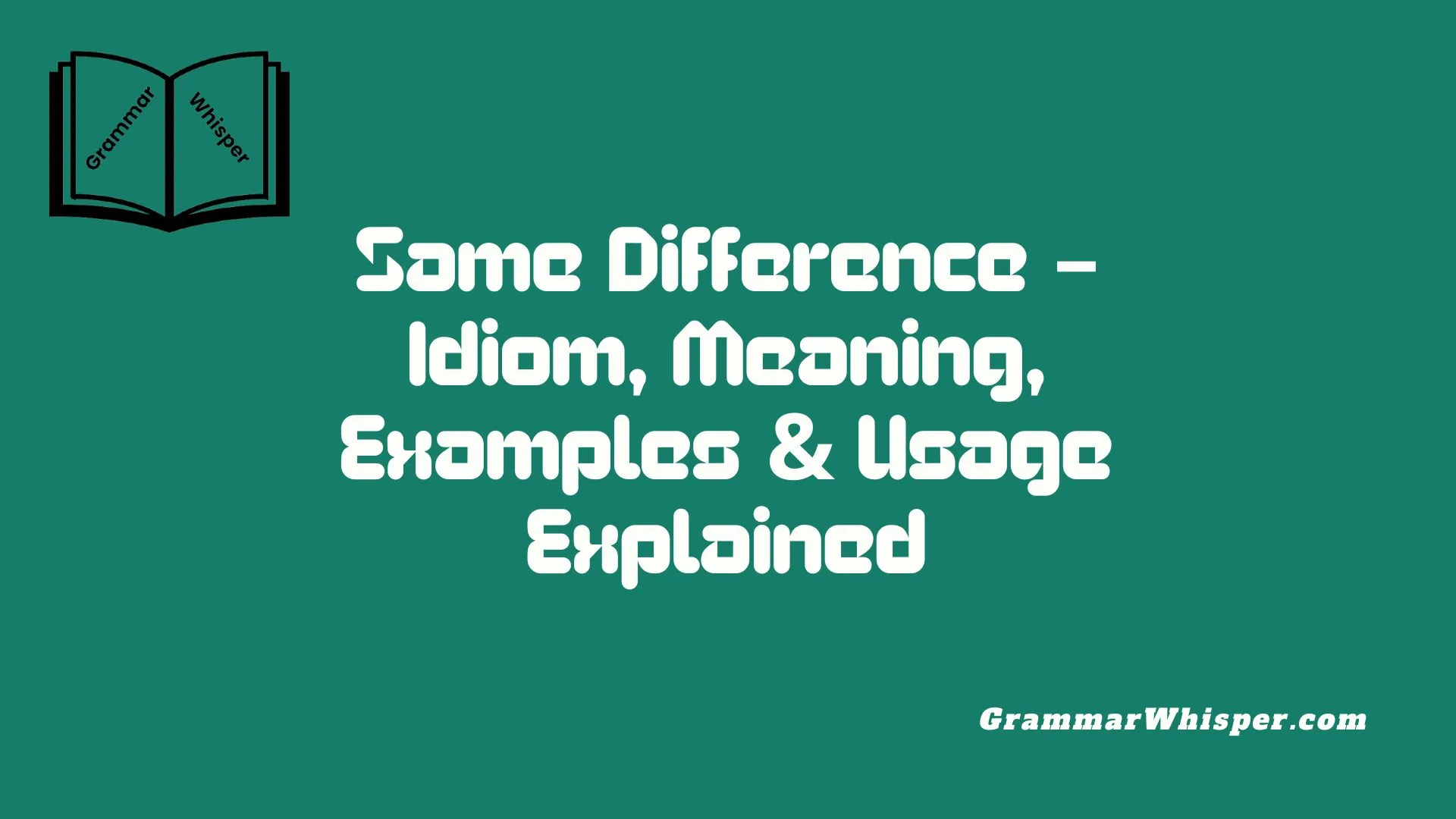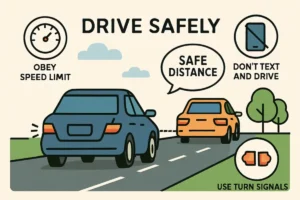When I was growing up, I’d often hear adults casually toss around the phrase “same difference” during conversations, and it always made me pause. The contradiction in those two words sparked my curiosity. How could something be both the same and show a difference? This kind of quirky, playful expression is exactly why I love the English language. It bends logic in favor of playfulness, and that’s what makes idioms fascinating. Many people use this idiom instinctively, brushing off small distinctions that don’t really matter. Over time, I started noticing how such phrases add a splash of flavor to everyday speech. They help us communicate in a more casual, even colorful way.
Later, I got curious about the history of this particular phrase and uncovered a rather interesting story. Its origins can be traced back to American vernacular, a space where irony and humor often collide. I once came across a guide that broke down the meaning behind idiomatic speech and how idioms like these evolve over time. Although it might sound completely nonsensical at first, the uses of “same difference” are actually quite practical – often highlighting that two things, though different in wording, lead to the same outcome. It may not align with traditional rules, but it works. That contradiction is part of the beauty of English.
What Does “Same Difference” Actually Mean?
At face value, the phrase “same difference” sounds like nonsense. How can something be both same and different at once? Yet, in everyday English, this idiom means “no real difference” or “it doesn’t matter”. People say it to show that two things might seem different but, practically, they’re essentially the same.
For example:
- “You say tomato, I say tomahto – same difference.”
- “Whether you take the bus or the subway, it’ll take the same time – same difference.”
In short, “same difference” signals that differences are trivial or irrelevant. It’s a casual way of brushing off fine distinctions and focusing on the bigger picture.
Why Use “Same Difference”?
- It saves time when debating tiny details.
- Shows casual agreement despite minor disagreements.
- Adds a touch of humor or sarcasm.
Tone and Context: How “Same Difference” Fits Into Conversation
“Same difference” has an informal, conversational tone. You’ll hear it mostly in casual talks with friends, family, or colleagues, not in formal writing or professional meetings. It often carries a playful or slightly sarcastic vibe, especially when someone wants to dismiss an argument about small discrepancies.
Here are some common tones and contexts:
| Tone | Example Situation | Meaning Conveyed |
| Casual | Friends deciding on dinner options | Minor choices don’t matter |
| Sarcastic | Two people arguing about a small detail | Difference is insignificant |
| Humorous | Joking about alternative spellings or phrases | Lighthearted dismissal of differences |
Using “same difference” tells listeners you value efficiency and don’t want to waste energy on trivial distinctions.
Real-Life Examples of “Same Difference” in Dialogue
To get a feel for how “same difference” appears naturally, let’s look at a few dialogues:
Example 1: Alex: “I think the blue shirt looks better.” Jamie: “Well, the green one is basically the same difference.”
Here, Jamie means both shirts serve the same purpose and the color difference isn’t worth arguing over.
Example 2: Sara: “Is it called a couch or a sofa?” Mike: “Same difference, both mean the same thing.”
Example 3: Co-worker 1: “The meeting starts at 2 or 2:15, right?” Co-worker 2: “Same difference. We’ll get started around then.”
These examples reveal how the phrase helps smooth over minor disagreements or uncertainties without tension.
Origin and Historical Roots of “Same Difference”
Tracking down the exact origin of “same difference” is tricky, but linguists date it back to at least the mid-20th century. It appears primarily in American English slang, emerging as a playful oxymoron – two contradictory words joined to express a particular idea.
Key Historical Facts:
- The phrase likely gained popularity in the 1950s and 1960s through informal speech and popular media.
- Early uses appear in American movies, TV shows, and literature, highlighting its colloquial status.
- It exemplifies how language evolves creatively – combining words in surprising ways to express complex attitudes with brevity.
The term “same difference” stands as a fine example of how English embraces paradoxes to enrich communication.
Linguistic Evolution: Why Did “Same Difference” Stick?
Language trends come and go, but “same difference” survived because it’s catchy and practical. Its oxymoronic nature makes it memorable, and people love idioms that capture common feelings in a fun way.
Factors Behind Its Popularity:
- Simplicity: Easy to say and understand.
- Expressiveness: Communicates complex ideas (accepting minor differences) with two words.
- Versatility: Fits many informal situations.
- Cultural Impact: Appears in movies, TV shows, and social media, reinforcing usage.
In fact, it’s featured in popular TV sitcoms like Friends and The Simpsons, helping embed the idiom in everyday speech.
Similar Idioms & Their Nuances
“Same difference” isn’t alone in expressing the idea that two things are basically alike despite differences. Here’s a quick comparison with related idioms:
| Idiom | Meaning | Tone | Usage Context |
| Same difference | No meaningful difference | Casual, informal | Everyday conversation |
| Six of one, half a dozen of the other | Equal or no real difference | Neutral, informal | Comparisons |
| Potato, potahto | Different ways to say the same thing | Playful, humorous | Light debates |
| It’s all the same | No difference, indifferent tone | Slightly formal | Broader discussions |
Each phrase varies in tone and context. For example, “potato, potahto” often sounds funnier or more playful, while “it’s all the same” can come off as more resigned or neutral.
Regional and Cultural Usage Variations
Is “same difference” equally common everywhere? Not quite. It’s predominantly American English slang, and its familiarity may vary depending on the speaker’s region or generation.
Usage Insights:
- United States: Widely recognized and used, especially in casual speech.
- United Kingdom: Known but less common, sometimes replaced by alternatives like “six of one, half a dozen of the other.”
- Australia/Canada: Occasionally used but less frequently.
- Generational Differences: Younger speakers tend to use it more often in text and speech.
Cultural Perception
- Some older or more formal speakers might find it too informal or unclear.
- Younger audiences and casual speakers embrace it for its humor and efficiency.
Grammar & Phrase Structure: Why “Same Difference” Works
At first glance, “same difference” seems grammatically odd – it pairs an adjective (same) with a noun (difference) that contradicts it. Yet, it works because it’s an idiomatic expression, not a literal phrase.
How it functions:
- The phrase acts as a fixed expression or set phrase – meaning arises from usage rather than direct grammar.
- The oxymoron creates a memorable, punchy effect.
- Similar constructions exist in English, like “bittersweet” or “deafening silence.”
Idioms like this enrich English by packing complex meanings and emotions into small phrases.
When Not to Use “Same Difference”
Though versatile, “same difference” isn’t suitable everywhere. Here’s when to avoid it:
- Formal writing: Business reports, academic papers, legal documents.
- Professional settings: Meetings where clarity and precision matter.
- Serious discussions: Topics that require nuanced understanding.
- International audiences: When you can’t be sure everyone knows the idiom.
Alternative phrases for formal use:
| Informal Idiom | Formal Equivalent |
| Same difference | No significant difference |
| Six of one, half a dozen | Equally acceptable options |
| It’s all the same | No material difference exists |
Using “same difference” in the wrong setting risks confusion or seeming unprofessional.
Summary & Key Takeaways About “Same Difference”
The idiom “same difference” packs a lot into a small phrase. It signals that differences don’t really matter, blending contradiction and humor to convey casual dismissal of trivial distinctions. While rooted in mid-20th century American English, its clever oxymoronic style has helped it thrive in popular speech.
What to remember:
- It’s informal and conversational, best suited for casual chats.
- Its tone ranges from playful to sarcastic.
- It’s not appropriate for formal or professional contexts.
- Related idioms provide similar shades of meaning.
- It reflects English’s love of paradox and creativity.
Use “same difference” wisely to add flavor to your conversations and express yourself succinctly when details don’t need fussing over.
Bonus: Quick Reference Chart for “Same Difference” Usage
| Situation | Use “Same Difference”? | Reason |
| Casual conversation | ✅ Yes | Fits informal tone perfectly |
| Business emails | ❌ No | Too informal and ambiguous |
| Academic writing | ❌ No | Lacks precision |
| Text messages | ✅ Yes | Common and understood |
| Formal speeches | ❌ No | Too casual and potentially unclear |
Case Study: “Same Difference” in Popular Media
The phrase appears frequently in TV and movies, helping cement its place in everyday language.
- In Friends (Season 6, Episode 3), Chandler jokes about trivial differences in spelling: “It’s like ‘tomato’ and ‘tomahto.’ Same difference.”
- The Simpsons use it to mock petty disagreements in Springfield’s community dialogues.
These appearances help normalize the idiom, showing how media shapes language trends.
Final Thoughts
English idioms like “same difference” enrich communication, letting speakers express complex attitudes with wit and brevity. Understanding its meaning, tone, history, and proper use equips you to join conversations confidently and sound naturally fluent. So next time you want to shrug off a tiny disagreement, you know just what to say!
If you want, I can also help with more idiomatic expressions, their origins, or usage tips. Just ask!
FAQS:
What does the idiom “same difference” mean?
“Same difference” means that two things are essentially the same despite minor differences. It’s a casual way to say that the distinction doesn’t really matter or affect the overall meaning.
Is “same difference” formal or informal language?
It is an informal, conversational idiom. It’s commonly used in casual speech and writing but should be avoided in formal or professional contexts where precise language is required.
Where did the phrase “same difference” originate?
The phrase likely originated in mid-20th century American English slang, becoming popular through informal speech and media such as movies and TV shows. Its exact origin is unclear but reflects English’s tendency for playful oxymorons.
Can I use “same difference” in writing?
You can use “same difference” in informal writing such as texts, emails to friends, or casual blog posts. However, it is not recommended for academic papers, business documents, or formal communication due to its informal tone.
Are there similar idioms to “same difference”?
Yes! Some similar expressions include:
- “Six of one, half a dozen of the other” – meaning two options are equal.
- “Potato, potahto” – highlighting different ways of saying the same thing.
- “It’s all the same” – expressing no meaningful difference.
Each has a slightly different tone and usage but conveys a similar idea.











